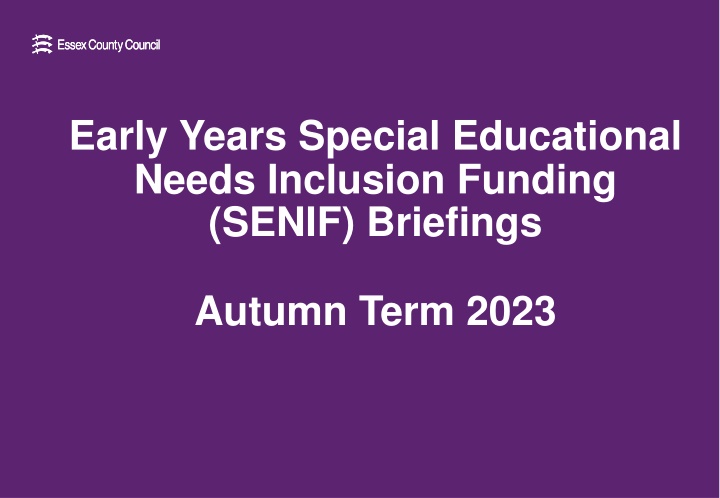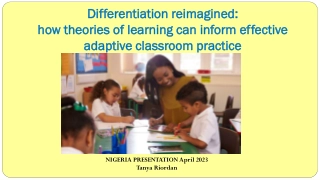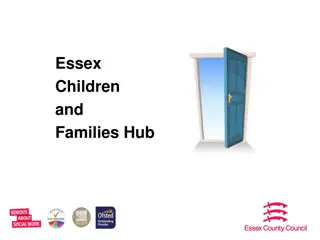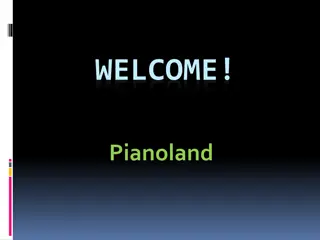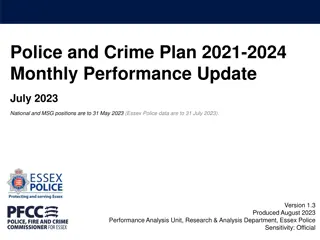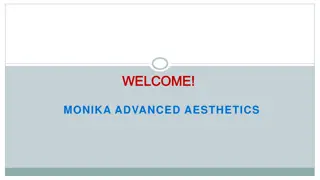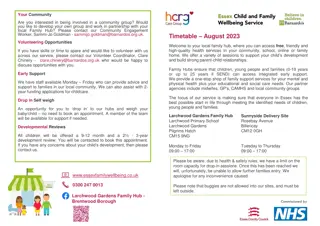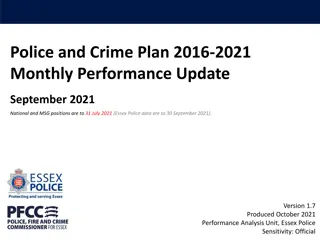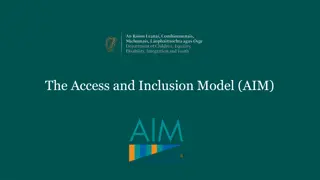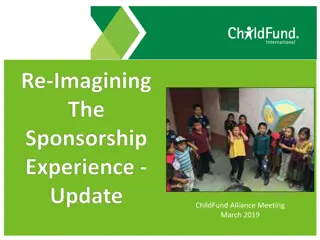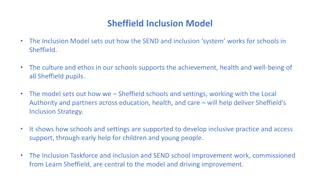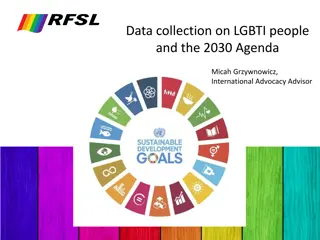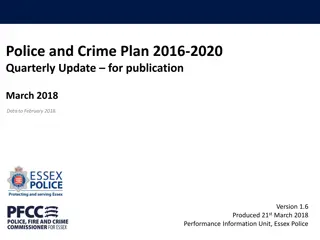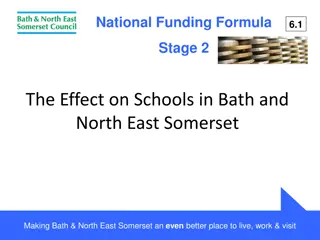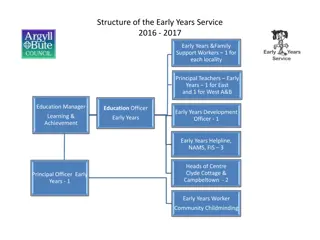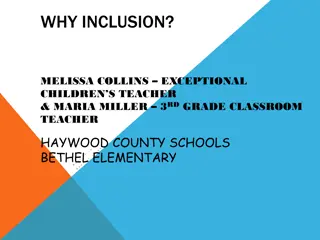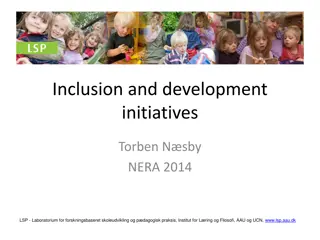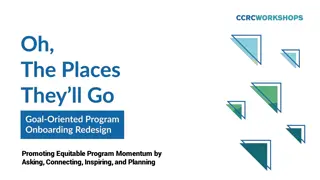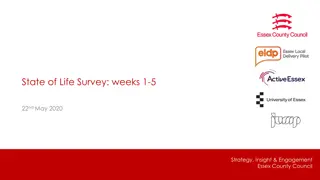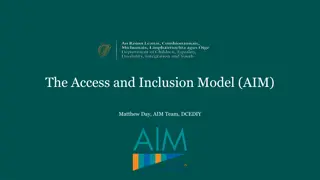Reimagining Early Years Special Educational Needs Inclusion Funding in Essex
The initiative aims to streamline and enhance SEN top-up funding arrangements in Essex to ensure fair, transparent, and sustainable provisions across all educational sectors. By simplifying existing funding structures, creating a single banding framework, and aligning with broader SEN policies, the program seeks to improve support for young people from birth to 25 years.
Download Presentation

Please find below an Image/Link to download the presentation.
The content on the website is provided AS IS for your information and personal use only. It may not be sold, licensed, or shared on other websites without obtaining consent from the author.If you encounter any issues during the download, it is possible that the publisher has removed the file from their server.
You are allowed to download the files provided on this website for personal or commercial use, subject to the condition that they are used lawfully. All files are the property of their respective owners.
The content on the website is provided AS IS for your information and personal use only. It may not be sold, licensed, or shared on other websites without obtaining consent from the author.
E N D
Presentation Transcript
Early Years Special Educational Needs Inclusion Funding (SENIF) Briefings Autumn Term 2023
What we hope to cover in todays session. 1 2 3 4 5 6 Recap of the Rationale Where are we now in the process? What do providers need to be aware of? My Early Years One Plan - a needs led approach. Transition Funding Update Questions
The case for change: Recap on why we are introducing new SEN top-up funding arrangements in Essex To create a single, universal approach to SEN top-up funding in Essex that applies to all phases and settings, ensuring funding is governed by consistent principles; is easy to understand, fair, efficient, and transparent; and is part of a robust SEN system, aligns to key Essex-wide policies (EHCNA guidance, ordinarily-available provision, Panels), and is consistently applied across the county. Overall aim Put simply, the current top-up funding arrangements in Essex do not deliver on these aims. Current SEN top-up funding arrangements are unnecessarily complex and confusing. Each sector uses a different methodology to decide on the allocation of top-up funding. Early years multiple funding streams, complex, no alignment with school-age funding. Schools banding system has compromised by additional elements added (provision, fixed / default top-ups). Inconsistent application. Overly complex. Not transparent. Post-16 individually-negotiated top-ups not sustainable or equitable. Current arrangements do not offer a robust, equitable and sustainable basis for arranging top-up funding, in the medium term and in anticipation of any national changes. Main issue The review is being undertaken from a principled basis we want to have a fair, transparent, coherent and sustainable system. The review is not being driven by the need to make financial savings. As its starting point, for early years and across all sectors, the review is considering how existing levels of resources (and any future uplift) can be distributed in the fairest way. Myth- busting 4
Recap on the aims of the review and re-design of SEN top-up funding arrangements in Essex Aim: To create an effective, fair and coherent system for SEN top-up funding one that covers and links all phases and settings, for young people from birth to 25. The aim of the SEN top-up funding review Scope: SEN top-up arrangements in all phases and sectors of education early years, mainstream primary & secondary schools, special schools, and colleges. Focus: On aspects of SEN funding that can be determined locally, with a specific focus on the methodology for how SEN top-up funding is arranged fairly and transparently. What this means specifically in the context of the early years 1. Simplifying the three existing strands of early years top-up funding (all with different sources, tools, paperwork and decision-making processes) into two strands using the same tool and processes. 2. As part of an overarching approach to arranging top-up funding that aligns with arrangements for school-age children to support transitions. Current system Outcome of this review Early Years Inclusion Funding (L/M/H bands) SEN Premium Funding (10 levels) EY children with EHCPs (Banding matrix, 6 bands) SEN Inclusion Funding EHCP top-ups Single banding framework (same decision- making tool used for all EY CYP) 5
Recap on the Essex all-age / cross-phase banding descriptors In the summer term of 2022, we established an Early Years Task-and-Finish Group, made up of representatives of the sector and LA officers. The primary task of the Group was to develop an early years version of the Essex banding descriptors for allocating top-up funding. There were two exam questions on which we focused. Based on the Group s work, we co-developed a set of early years banding descriptors. Q1. We agreed where we should set the dividing line between additional needs / SEN support and the first ( Low ) band of top-up funding, and drafted descriptors to reflect this. Q2. We adapted the all-age banding descriptors, and developed and tested descriptors for the Low , Medium and High bands specifically relevant to early years. Add. needs and SEN support Top-up Band Low Top-up Top-up Band High Universal support Early years Band Medium NB Early years banding descriptors align with those for schools and colleges, but it is not the case that children on early years bands will automatically move to the equivalent top-up band when they reach school age. Mainstream schools and colleges Universal support (Band A) SEN support (Band B) High needs top-up Band C High needs top-up Band D High needs top-up Band E High needs top-up Band F High needs top-up Band G Special schools and units Place funding 6
Activity since last SENIF Briefings Development of a new Early Years Resource Panel Introduction of a new Early Years Early Intervention Partner resource Shadow banding of SENIF descriptors to test methodology Review of One Planning template Development of an on-line SENIF application form Review on Transition funding
SEN Top Up Funding (SENIF) current information As many of you may be aware ECC are working on bringing together the SENP and Inclusion Funding panels. This work will be going on behind the scenes, but we would like to share a few relevant changes which you will start to see, at this point:- All applications for Inclusion Funding will go the Early Years Resource Panel, as will children with a S23 notification who are initially funded in the Autumn term (or later). Children who were funded prior to the Autumn term will continue to be reviewed by panel members. The Early Years Resource Panel can allocate a monetary resource or a non- monetary resource. Monetary resource will be SENIF (Special Educational Needs Inclusion Funding) from Sept 24 Non-monetary resource could be contact with an Inclusion Partner (IP), Early Years Education Partner (EYEP) or Early Years Early Intervention Partner (EYEIP)
SEN Top Up Funding (SENIF) current process At this point: - Inclusion Funding submissions will continue as they are done presently, and will be submitted through the EY Inclusion Funding inclusion.funding@essex.gov.uk An application form and One Planning will need to be submitted in the same way as it is presently for Inclusion Funding. SENP will still be submitted through the Pre-school Allocations Panel preschoolpanel@essex.gov.uk For SENP a short cover form will be required to be submitted alongside your One Planning which can be located at https://eycp.essex.gov.uk/funding/special-educational-needs-sen-premium/ Panel dates and submission dates are on the Early Years and Childcare Website https://eycp.essex.gov.uk/funding/inclusion-funding/early-years- resource-panel-meeting-dates/ Any process updates will be put on the Early Years and Childcare Website.
Panel Meetings Dates Details on the meeting dates can be found here https://eycp.essex.gov.uk/funding/inclusion-funding/early-years-resource-panel-meeting-dates/ Spring term submissions for SEN Premium funding must be madeon or before 01/03/24 for consideration at March panel at the latest. Summer term submissions for SEN Premium funding must be made between 02/03/24 and 01/07/24 for panels in April, May, June and July Autumn term submissions for SENIF funding must be made between 02/07/24 and 01/12/24 for panels in August, September, October, November and December 1st July 2024 final date for submissions of one plans along with accompanying cover forms for SEN Premium and Inclusion Funding (Summer Term funding) 2nd July 2024 onwards all applications will now be considered against the SENIF funding criteria for Autumn term resourcing
Non-Monetary Resource available New Early Years Early Intervention Partner (EYEIP) resource The EYEIP team is an enabling resource to support settings to understand and meet the developmental needs of children, where further exploration is needed before being described as having an emerging need. The EYEIP resource can only be accessed via the Early Years Resource Panel allocation The support from the EYEIP team will help you consider areas such as: Enabling environment to meet children s needs Adult relationships and interactions Transitions and routines Provision and practice Practitioner confidence You can expect your allocated EYEIP to spend time with you in the setting as a critical friend to reflect and understand why an assessment of emerging need has been made. They are an empowering role that will support you to consider your observations/assessments, practice and environments and think about how you can make adjustments to meet the child s needs.
Non-Monetary Resource available Inclusion Partner (IP) Your allocated IP can support you to fulfil your statutory duties for children with SEND. They can help you develop your inclusive practice to deliver improved outcomes for children with SEND, through implementation of the person centred graduated approach (One Planning), enabling practitioners to monitor and review progress. Early Years Education Partners (EYEP) can work with you to review and develop all aspects of your EYFS provision and practice to ensure that statutory requirements are met and that it supports the needs of all children as effectively as possible. They can signpost you to information and materials to enable a high level of support for all children.
My Early Years One Plan Evidence of Need
Settings must include the following information as set out by the SEND Code of Practice 0-25 years (2015) Clearly outlining the child s needs Shows progress made by the child Record of the child s aspirations (long term ambition or hopes) Outcomes (steps towards the aspiration) SMART Targets (small steps towards the outcomes) Record of resources needed (includes use of staff) Start and Review dates. Space to record the progress made towards targets, outcomes and aspirations at the review point Evidence that the document has been co-produced (evidence of the voice of the child and their parents and carers, practitioners and where relevant, other professionals)
My Early Years One Plan All children are continuously assessed by early years practitioners and other professionals involved with a child. Please record information based on the evidence of assessments, including observations, carried out and describe the child s strengths and needs (what they can and cannot do). It is essential to provide information about severity of need (for example occasional, regular, frequent, persistent). Consider what the child is finding hard as well as what they can do and what this looks like in practice. (Please bear in mind that the Essex early years banding descriptors are based on evidence of need. This is crucial to ensuring that children with the same needs, in the same type of settings, receive the same level of funding.)
Health Care Plans https://assets.publishing.service.gov.uk/media/5a75090 f40f0b6360e472d23/Supporting_pupils_with_medical_c onditions_-_templates.docx
Early Years Transition Funding Review undertaken on: - current IPRA funding process how a new transition funding model would link to existing processes Decision taken to pause implementing a new Early Years transition funding process until the Summer 2025 term
